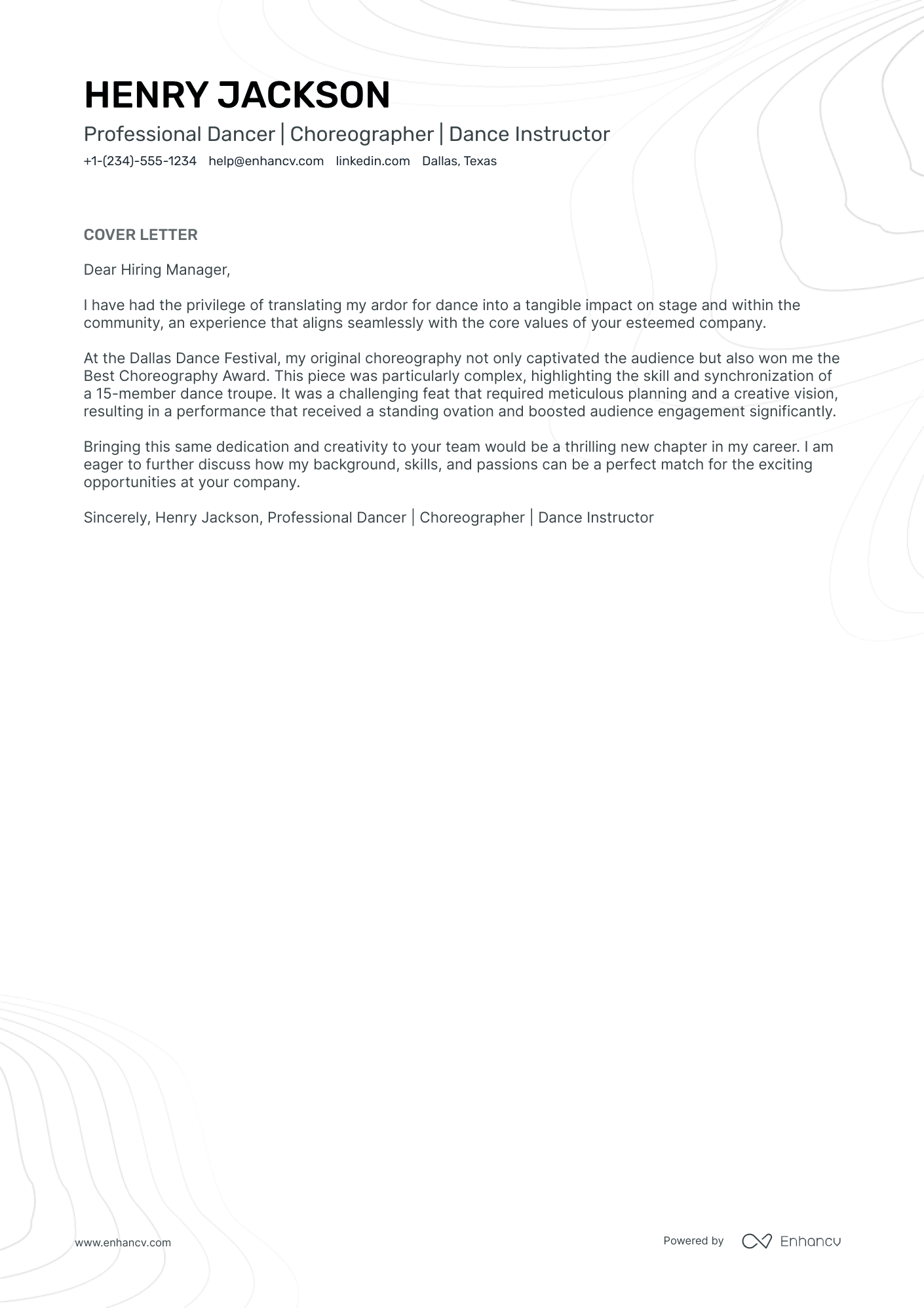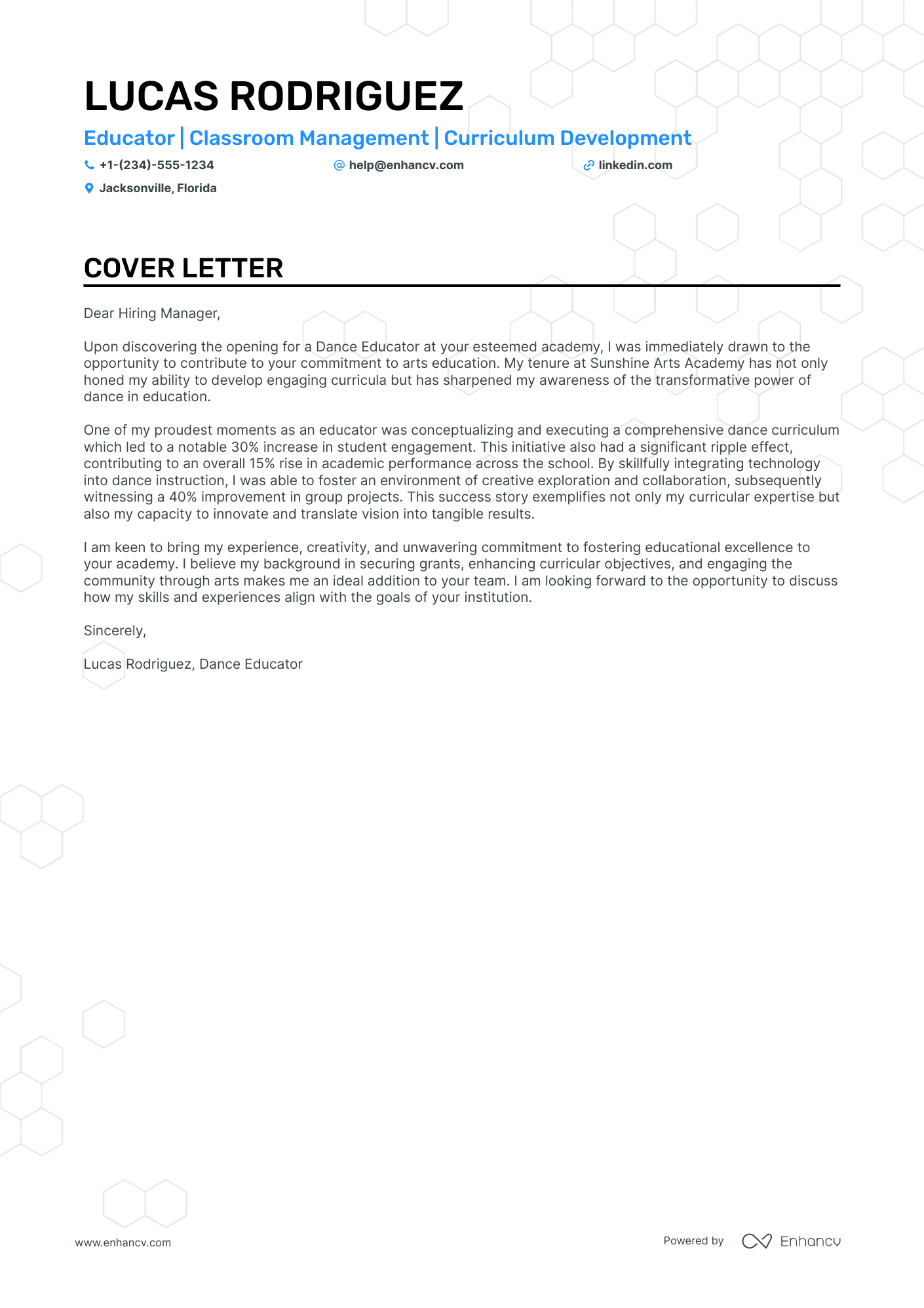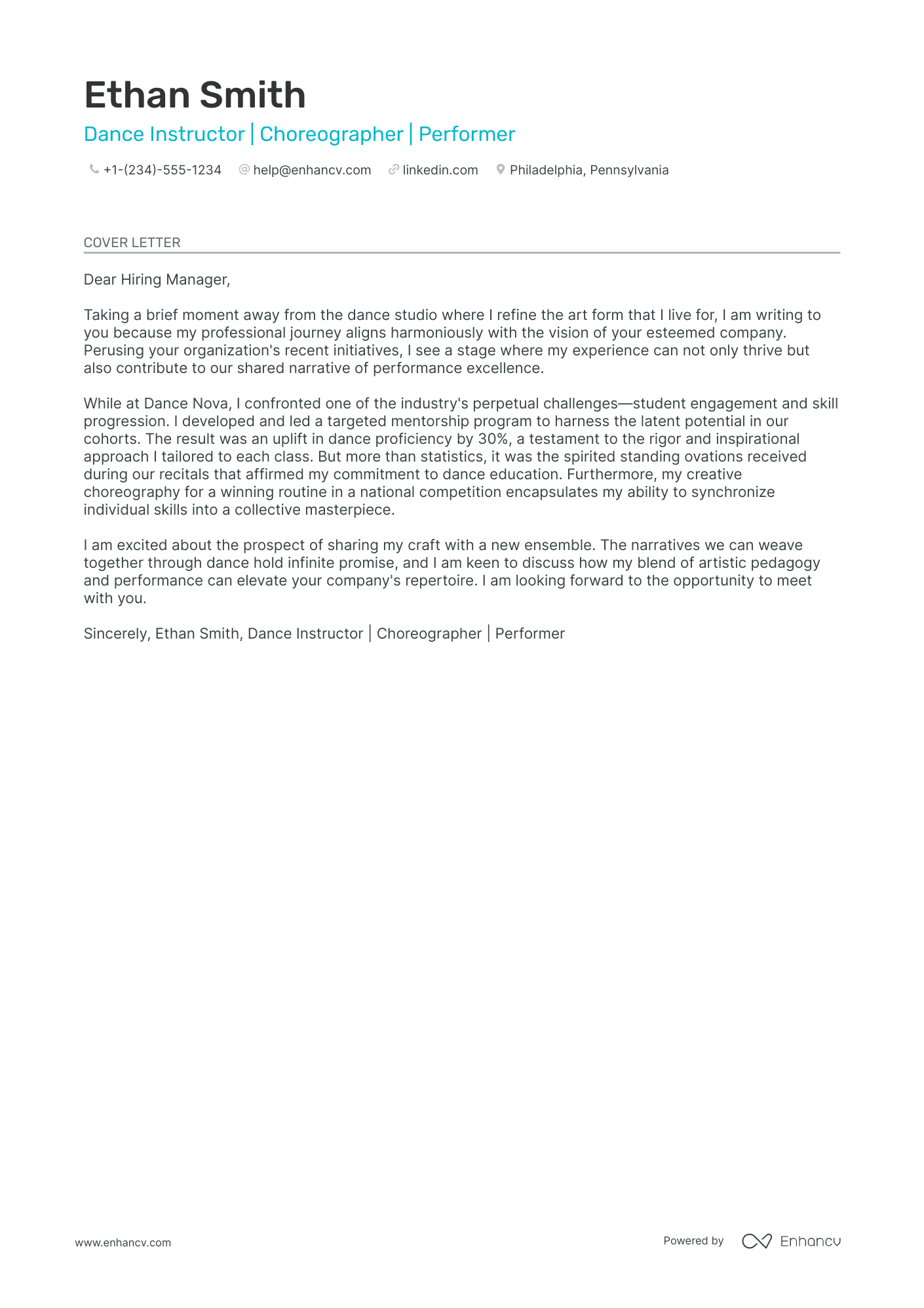Embarking on the job hunt, you've fine-tuned your resume and now it's time to pair it with a stellar dance cover letter. Crafting a cover letter can be tricky; you want to encapsulate your proudest achievement without echoing your resume. It's about striking the right balance - showcasing your unique story formally while dodging overused phrases. And remember, brevity is key: your impactful narrative should unfold in just one page. Let's step through how to create a cover letter that dances right off the page.
- Personalize your dance cover letter and get inspired by other professionals to tell a compelling story;
- Format and design your dance cover letter to make an excellent first impression;
- Introduce your best achievement in your dance cover letter to recruiters;
- How to make sure recruiters get in touch with you, using your dance cover letter greeting and closing paragraphs.
What is more, did you know that Enhancv's AI can write your cover letter for you? Just upload your dance resume and get ready to forward your job application in a flash.
If the dance isn't exactly the one you're looking for we have a plethora of cover letter examples for jobs like this one:
Drop your resume here or choose a file.
PDF & DOCX only. Max 2MB file size.
Dance cover letter example
Joseph White
Austin, Texas
+1-(234)-555-1234
help@enhancv.com
- Emphasizing Relevant Experience: The cover letter highlights the candidate's role as a Senior Dance Instructor and their success in curricular innovation, which is directly applicable to the Adjunct Faculty position in a dance division.
- Demonstrating Impact: Specific achievements, such as increasing enrollment, enhancing the academy’s reputation, and leading large scale performances, showcase the candidate’s ability to make a tangible impact and contribute to the success of the program.
- Expressing Specific Interests: A clear expression of interest in the specific institution and a willingness to further discuss alignment with the department’s goals suggest genuine enthusiasm for the role and an understanding of the institution’s values and expectations.
What are the basics of the design or format of your dance cover letter?
To start, here's a reminder for you: the Applicant Tracker System (or software that is used to assess candidate profiles), won't be reading your dance cover letter.
Recruiters enjoy reading dance cover letters with a standardized format that uses:
- the same font as the resume (e.g. modern ones like Raleway or Volkhov are prefered over the clichéd Times New Roman or Arial);
- single spacing to keep the content concise and organized (this is all ready for you in our cover letter templates);
- a one-inch margin to wrap around the text, like in our cover letter builder;
- PDF as a file format, as it allows your design (and visual element) to stay the same.
Finally, we can't go on without mentioning the key sections of your dance cover letter.
In the top one-third, make sure to include a header (with your contact information, name, role, and date), a salutation, and an introduction.
Next, follows the heart and soul of your dance cover letter or its body.
End your dance cover letter with a closing paragraph and, if you wish, a signature.
Writing a cover letter is easy with our free cover letter generator. Make one in seconds from your resume.
The top sections on a dance cover letter
- Header: This should include your personal contact information, the date, and the recipient's details, giving the letter a professional look and making it easy for the recruiter to know who you are and how to contact you.
- Greeting: Use a personalized greeting to address the specific individual or group, such as the dance company director or recruiting panel, to show respect and a genuine interest in the position.
- Introduction: Open with a compelling statement that highlights your passion for dance, your specific style or experience, and how it aligns with the dance company's ethos or the particular project you are applying for.
- Dance Experience and Achievements: This section outlines your relevant dance background, notable performances, and any unique skills or accolades that make you stand out as an exceptional candidate for the dance role.
- Closing and Call to Action: Conclude with a strong closing statement that reiterates your enthusiasm for the opportunity, thanks the recipient for considering your application, and invites them to contact you for an audition or interview.
Key qualities recruiters search for in a candidate’s cover letter
- Technical proficiency in various dance styles: Recruiters look for dancers with strong technique and the ability to perform multiple dance genres to fit diverse choreography demands.
- Performance experience: A history of performances, whether in competitions, shows, or concerts, indicates a candidate's comfort on stage and ability to engage with an audience.
- Physical fitness and endurance: Dance is physically demanding, so being fit and able to sustain energy throughout rehearsals and performances is crucial.
- Adaptability and quick learning skills: Dancers often need to learn new routines quickly and adjust to different choreographers' styles, making adaptability a sought-after trait.
- Creativity and expression: The ability to interpret music and convey emotion through movement is essential for standing out in performances and contributing to a group's dynamic.
- Teamwork and collaboration: Being a team player who can work well with other dancers, choreographers, and production staff is important for creating a cohesive performance.
What greeting should you use in your dance cover letter salutation
A simple "Hello" or "Hey" just won't work.
With your dance cover letter salutation, you set the tone of the whole communication.
You should thus address the hiring managers by using their first (or last name) in your greeting.
But how do you find out who's recruiting for the role?
The easiest way is to look up the role on LinkedIn or the corporate website.
Alternatively, you could also contact the organization via social media or email, for more information.
Unable to still obtain the recruiter's name?
Don't go down the "To whom it may concern path". Instead, start your cover letter with a "Dear HR team".
List of salutations you can use
- Dear Hiring Manager,
- Dear [Recipient's Name],
- Dear [Department] Team,
- Dear [Company Name] Recruiter,
- Respected [Recipient's Name],
- Dear [Recipient's Last Name],
First introductions in your dance cover letter
Within your dance cover letter introduction, genuinely state what you like about the organization.
Research the latest company projects, honorary awards, company updates, etc.
Write up to two sentences to let recruiters know what impresses you about the company,
This would help you to set a good tone for the rest of the communication.
How to select your best achievement for the middle, or the dance cover letter body
You probably feel exhausted by this point in your application: you've dived into all the details of your success and skills in your dance resume.
What else can you include in your dance cover letter body?
Well, for starters, the next three to six paragraphs should show you further value as a professional. Or, why should recruiters choose you?
Think back on a noteworthy achievement that answers key job requirements and dive deep.
Structure your dance cover letter middle as you'd a story: following chronological logic and highlighting outcomes, thanks to skills.
At the end of the day, you'd want recruiters to be able to see you as the best candidate for the role and understand more about who you are and what makes your success unique (and valuable to the role).
Finishing off your dance cover letter with what matters most
So far, you've done a fantastic job in tailoring your dance cover letter for the role and recruiter.
Your final opportunity to make a good impression is your closing paragraph.
And, no, a "Sincerely yours" just won't do, as it sounds too vague and impersonal.
End your dance cover letter with the future in mind.
So, if you get this opportunity, what do you plan to achieve? Be as specific, as possible, of what value you'd bring to the organization.
You could also thank recruiters for their interest in your profile and prompt for follow-up actions (and organizing your first interview).
Lacking experience: here's how to write your dance cover letter
As a candidate with no experience, it's important to be honest from the get-go of your application.
Use your dance cover letter to sell your unique talents. Choose an accomplishment from your academic background or your volunteer work to show the skills that are relevant to the role.
Focus on your career objectives and how you see the job to align with them. Be specific and, at the same time, realistic about where you picture yourself in five years.
Key takeaways
Winning at your job application game starts with a clear and concise dance cover letter that:
- Has single-spaced paragraphs, is wrapped in a one-inch margin, and uses the same font as the dance resume;
- Is personalized to the recruiter (using their name in the greeting) and the role (focusing on your one key achievement that answers job requirements);
- Includes an introduction that helps you stand out and show what value you'd bring to the company;
- Substitutes your lack of experience with an outside-of-work success, that has taught you valuable skills;
- Ends with a call for follow-up or hints at how you'd improve the organization, team, or role.
Dance cover letter examples
By Experience
Dance Student
By Role








